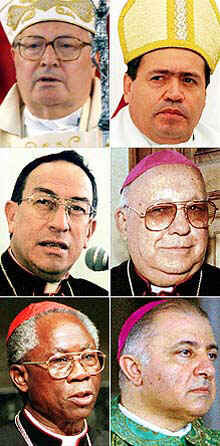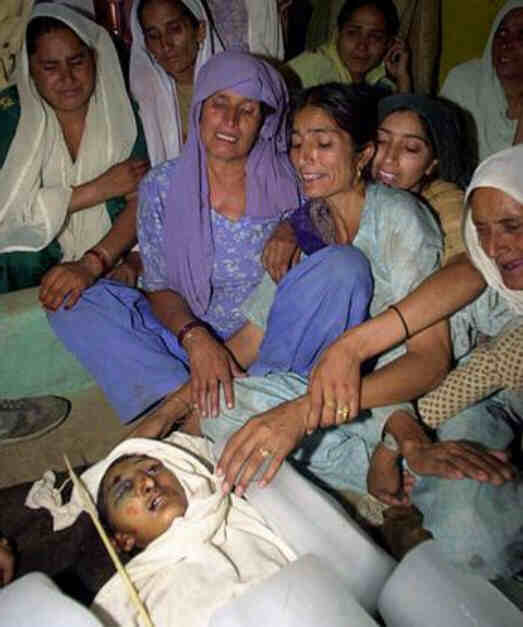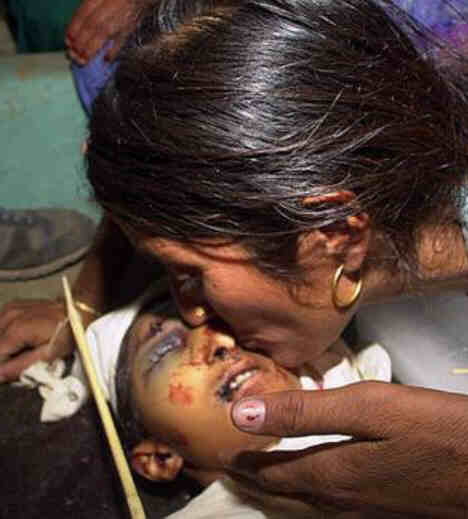2001 Hamad Abu Khosa, 45, and Ahmad Ala’jami, 27, from
Alboraij Refugee Camp in the Gaza Strip, shot by Israeli soldiers east of
the camp.
2001 Newborn Mibenge, minutes old, swallowed by
python, near Serenje, Zambia (date estimated from fact that Zambian
TV reported it on 22 May). Joyce Mibenge was on her way to plough fields
one and a half kilometers from her home when she went into labor. When she
had recovered enough to hold her baby she saw a python which had engulfed
it whole, but for the legs. She did not even know whether she had had a
boy or girl.
2001: 34 Turkish soldiers, of an elite
special unit, as a military CASA CN 235 transport crashes in Turkish-occupied
Kurdistan.
 1998
— Mikael Nickkolauson, 17,
^top^ 1998
— Mikael Nickkolauson, 17,
^top^
killed by fellow student, Kipland
P. Kinkel, 15, in Springfield, Oregon. The previous evening Kip
had killed his parents. This morning he goes to Thurston High School
where he shoots 48 rounds from a semi-automatic rifle in less than
one minute, killing Mikael Nickkolauson, and wounding more than 20
other persons, one of which, Ben Walker, 16, dies the next day from
his injuries.
Those who
were hospitalized for their wounds are: |
Jennifer Alldredge, 17, wound to chest/hand/neck
Ryan Atteberry, 17, wound to face
Sara Branom, 15, wound to right thigh
Tony Case, 17, wound to chest/abdomen/leg
Nathan Cole, 17, wound to abdomen
Tabitha Fain, 14, wound to thigh
Melissa Femrite, 16, wound to left forearm
Trina Harty, 17, wound to left leg
Kyle Howes, 16, broken tibia and lacerated thigh
Betina Lynn, 18, wound to ankle
Carolyn McClain, 15, wound to right arm
|
Elizabeth McKenzie, 15, wound to left hip
Tara McMullen, 15, broken right rib
Teresa Miltonberger, 16, wound to head
Christina Osburn, 17, gunshot wound to pelvis
Joshua Pearson, 17, wounded in buttocks
Richard Peek, 17, wound to left arm
Amber Ramsey, 15, wound to right hip
Jacob Russell Ryker, 17, wounded in chest, hand
Melissa Taylor, 15, wound to shoulder
Gabriel Thomas, 17, wound to left shoulder
Jesse Walley, 16, wound to stomach |
| (Some shooting victims were never hospitalized
and thus do not appear on the list above. For example Nichole Buckholtz,
17, was wounded in the right leg and treated by a family doctor.)
[News
stories archive] |
1996 At least 615 drowned as an overloaded Tanzanian ferry
capsizes in Lake Victoria.
1996
Sept moines trappistes du monastère de Medéa, Algérie,
^top^
Enlevés le 27 mars, ils sont assassinés par leurs ravisseurs.
L'obscure affaire des moines assassinés
(AFP, 21 et 22 juin, 15 juillet) Le Groupe Islamique Armé (GIA) dirigé
par Djamel Zitouni a adressé en mai et juin, via la radio franco-marocaine
de Tanger "Médi", une série de messages impliquant le gouvernement
français dans l'"affaire" des sept moines trappistes de Tibéhirine
enlevés le 27 mars et assassinés le 21 mai. Le 18 juin, un communiqué
du GIA relate une entrevue entre un émissaire du groupe et des diplomates
de l'Ambassade de France à Alger, le 30 avril, soit près d'un mois
avant l'enlèvement des moines. Le 16 avril, un message aurait été
adressé aux autorités françaises par Djamal Zitouni. Ce message aurait
fait part aux Français du désir du GIA de parlementer, et leur aurait
annoncé l'arrivée d'un émissaire dont la sécurité serait gagée par
la vie des moines. Le 30 avril, une rencontre se serait déroulée à
l'Ambassade de France entre un émissaire du GIA ("Abdullah") et des
diplomates français, lesquels auraient reçu la preuve que les moines
étaient toujours en vie, et une lettre précisant les modalités de
négociation. Les autorités françaises auraient remis à "Abdullah"
une lettre indiquant deux numéros de téléphone de contact et exprimant
le souhait de maintenir ce contact. L'émissaire du GIA aurait ensuite
été reconduit dans le quartier de Hussein Dey par une voiture de l'Ambassade,
en compagnie du diplomate Clément et du Consul français. Le porte-parole
du Ministère français des Affaires étrangères a confirmé la rencontre
avec le GIA de Zitouni mais a démenti que ce contact ait impliqué
le Consul général et toute tractation entre le France et les ravisseurs
des moines. De telles tractations ont cependant été évoquées par le
prieur du monastère d'Aiguebelle (Maison-mère du monastère de Tibéhirine).
Le prieur a ensuite été désavoué par le supérieur de la communauté,
lequel a été lui-même limogé et remplacé à son poste... par le prieur.
|
1995 Les Aspin, 36, from stroke; former US Secretary of
Defense
1991 Rajiv[aratna] Gandhi [Zindabad], former,
Indian Prime Minister, assassinated during national elections by a suicide
bomber.
1991 Jaime Gutiérrez Álvarez, Catholic priest,
rector of Colegio de La Salle in Medellín, Colombia, murdered by gunmen.
El 21 de mayo de 1991, el sacerdote Jaime Gutiérrez Álvarez, rector del
Colegio de La Salle de Medellín, fue muerto a dispararos.
1990
Mirwaiz Maulvi Mohammad Farooq, killed by unidentified gunmen,
in his house. He was a Kashmir independence leader. Later in the day more
than 50 persons are killed when Indian police open fire on mourners
carrying the body of Maulvi Farooq.
1989 John Richard Hicks,
economista británico, P. Nobel 1972.
1980 Salvador de Moxó
Ortiz de Villajos, historiador español.
1957 Aleksandr
Ivanovich Nekrasov , Russian astronomer and mathematical physicist
born on 09 December 1883.
1953 Ernst
Friedrich Ferdinand Zermelo, German mathematician born on 27
July 1871.
1942,
4300 Polish Jews ^top^
4300 Jews are deported from
the Polish town of Chelm to the Nazi extermination camp at Sobibor,
where all are gassed to death. Sobibor had five gas chambers, where
about 250'000 Jews were killed between 1942 and 1943. A camp revolt
occurred in October 1943; 300 Jewish slave laborers rose up and killed
several members of the SS as well as Ukrainian guards. The rebels
were killed as they battled their captors or tried to escape. The
remaining prisoners were executed the very next day. |
1940
the first of 1500 mental patients in East Prussia
^top^
A Nazi "special unit" carries out its mission-and murders more than
1500 hospital patients in East Prussia. Mentally ill patients from
throughout East Prussia had been transferred to the district of Soldau,
also in East Prussia. A special military unit, basically a hit squad,
carried out its agenda and killed the patients over an 18-day period,
one small part of the larger Nazi program to exterminate everyone
deemed "unfit" by its ideology. After the murders, the unit reported
back to headquarters in Berlin that the patients had been "successfully
evacuated." |
1937 Herbert
Ellsworth Slaught, US mathematician born on 21 July 1861.
1935 Jane
Addams, US social reformer and pacifist, born on 06 September
1860. In September 1889, with Ellen Gates Starr, she founded the social
services center Hull-House, at 800 South Halsted Street, Chicago. She shared
the 1931
Nobel Peace Prize (with Nicholas
Murray Butler [02 Apr 1862 – 07 Dec 1947]). She was the author
of Twenty Years at Hull-House (1919) — The Second Twenty
Years at Hull-House (1930) — Democracy and Social Ethics
(1902) — Newer Ideals of Peace (1907) — The Spirit
of Youth and the City Streets — (1910) — The Long Road
of Women's Memory (1916) — Peace and Bread in Time of War
(1922).
1924
Bobbie Franks, 14 ^top^
stabbed several times by his cousin Richard Loeb in the backseat of
a rented car as Nathan Leopold drives through Chicago's heavy traffic.
Leopold and Loeb had abducted Franks from a Chicago street. After
Franks bleeds to death on the floor of the car, Leopold and Loeb throw
his body in a previously scouted swamp and then disposed of the other
evidence in various locations. The case later proves to be one of
the most fascinating murders in American history.
The killers, Nathan Leopold and Richard Loeb, were extremely wealthy
and intelligent teenagers whose sole motive for killing Franks was
the desire to commit the "perfect crime." Leopold, who graduated from
the University of Chicago at age 18, spoke nine languages and had
an IQ of 200, but purportedly had perverse sexual desires. Loeb, also
unusually gifted, graduated from college at 17 and was fascinated
with criminal psychology. The two made a highly unusual pact: Loeb,
who was a homosexual, agreed to participate in Leopold's eccentric
sexual practices in return for Leopold's cooperation with his criminal
endeavors. Both were convinced that their intelligence and social
privilege exempted them from the laws that bound other people. Leopold
once wrote, "The superman is not liable for anything he may do, except
for the one crime that it is possible for him to commit-to make a
mistake." In 1924, the pair began to put this maxim to the test by
planning to commit a perfect murder. They each established false identities
and began rehearsing the kidnapping and murder over and over.
In an attempt to throw police off their
trail, they sent a ransom note demanding $10'000 to Franks' wealthy
father. But Leopold and Loeb were not "supermen"; they had made a
couple of key mistakes. First, the body, which was poorly hidden,
was discovered the next day. This prompted an immediate search for
the killers, which Loeb himself joined. The typewriter used to type
the ransom note was recovered from a lake and, more important, a pair
of glasses was found near Franks' body. When the glasses were traced
to the manufacturer, police learned that only three of its kind had
ever been produced. Two were immediately accounted for and the third
belonged to Nathan Leopold, who calmly told detectives that he must
have dropped them while bird hunting earlier in the week. This explanation
might have proved sufficient, but reporters covering the case soon
discovered other letters from Leopold that matched the ransom note.
When confronted with this evidence,
Leopold and Loeb both confessed. After Leopold's father got down on
his knees and begged Clarence Darrow to defend his son, the esteemed
attorney agreed, and the trial soon became a national sensation. Darrow,
who didn't argue the boys' innocence, directed one of his most famous
orations against the death penalty itself. The judge was swayed and
imposed life sentences. Apparently unsatisfied with the attorney's
work, Leopold's father later reneged on his contract to pay Darrow.
In January 1936, a fellow inmate killed Loeb in a bloody razor fight
in the prison's shower. Leopold was released on parole in 1958 with
help from noted poet Carl Sandburg, who testified on his behalf. He
lived out the rest of his life in Puerto Rico, where he died in 1971.
|
1923
Curley, Crow scout. ^top^
The Crow scout Curley, the last
man on the army side to see Custer and the 7th Cavalry alive, dies.
Two days later he would be buried at the National Cemetery of the
Big Horn Battlefield in Montana. Born around 1859 near the Little
Rosebud River, Montana, from an early age Curley had participated
in fights with the Crow's hated enemy, the Sioux. Like many of his
people, Curley viewed the Anglo-American soldiers as allies in the
Crow war with the Sioux. When he was in his late teens, he signed
on as a cavalry scout to aid the army's major campaign against the
Sioux and Cheyenne in the summer of 1876. Lieutenant Colonel George
Armstrong Custer and his 7th Cavalry arrived in the Powder River country
of southern Montana in early June 1876. As Custer proceeded toward
the Little Big Horn Valley, he found increasing signs that a large
number of Indians lay ahead. On 22 June, Curley and five other Crow
scouts were detached from a different unit and sent to Custer to bolster
his Arikara scouts. On the morning of 25 June, Curley and the other
scouts warned Custer that a massive gathering of Indians lay ahead
that far outnumbered his contingent of 187 men.
Custer dismissed the report and made the unusual decision to attack
in the middle of the day. Both the Crow and Arikara scouts believed
this would be suicidal and prepared to die. Right before the battle
began, however, Custer released the Crow scouts from duty. All of
the scouts, except for Curley, obeyed and rode off to relative safety.
However, since the hills were now swarming with small war parties
of Sioux and Cheyenne, Curley initially thought he would be safer
if he remained with the soldiers. As the fighting gradually began
to heat up, Curley reconsidered. He left Custer and rode to the east.
Concealing himself in coulees and ravines, Curley avoided attack and
made his way to a ridge about a mile and a half to the east. There
he watched much of the battle through field glasses, the last man
from the army side to see Custer and his men alive. When it had become
clear that Custer's army was going to be wiped out, Curley abandoned
his looking post and rode away to warn the approaching Generals Terry
and Gibbon of the disaster. In the weeks following the battle, Curley
provided an accurate and valuable account of the final moments of
Custer's 7th Cavalry. Unfortunately, some interviewers later pushed
the eager-to-cooperate Curley to revise his account and others simply
misrepresented his testimony to fit their own theories. Consequently,
for many years Curley was dismissed as a liar. Later historians, however,
have vindicated the accuracy of Curley's initial story. Little is
known about Curley's life after the Little Big Horn, but at some point
he moved to the Crow Agency in Montana where he dies of pneumonia
on 21 May 1923. Two days later, he is buried at the National Cemetery
at the Little Big Horn Battlefield. |
1915 Max Alfred Buri, Swiss artist born on 24 July 1868.
1882 Manuel Ancízar, escritor, abogado y periodista colombiano.
1875 Johann Adam Klein, German painter and printmaker born
on 24 November 1792.
1868 Jean-Antoine Duclaux,
French artist born on 26 June 1783.
1848 Pierre
Laurent Wantzel, French mathematician born on 05 June 1814.
1819 Dionys van Dongen, Dutch painter born on 03 September
1748. — MORE
ON VAN DONGEN AT ART “4” MAY
— Cattle
1813 Christiaen van Pol, Dutch artist born on 14
March 1752.
Condamnés
à mort par la Révolution:
^top^
1794 (2 prairial an II):
BROCHARDIERE François, secrétaire de son père, payeur
des dépenses du département de la guerre, domicilié à Vannes (Morbihan),
comme émigré, le 2 prairial an 3, par la commission militaire établie
à Bruxelles.
Par le tribunal révolutionnaire
d'Arras:
BARBIER Jean, 73 ans, marchand né à Veslis en Lorraine,
domicilié à Aire (Pas-de-Calais), comme ayant signé, en 1791, une
adresse tendante à obtenir des prêtres réfractaires, pour desservir
la paroisse Notre-Dame d'Aire
DELAHAYE Louis François Joseph, huissier, 32 ans,
né et domicilié à Aire (Pas-de-Calais), époux de Enet Claire Nicole,
comme ayant cherché à avilir les patriotes, tant par ses regards que
par ses discours insolents, ayant fait partie d'un club monarchique,
et signé en 1791 une adresse tendante à faire desservir Notre Dame
d'Aire par des prêtres réfractaires.
THOMAS Vindicien, fabricant de tabac, 45 ans, né
à Fléchinelle, domicilié à Aire (Pas-de-Calais), époux de Ockerman
Thérèse, comme conspirateur ayant traité les députés à la Convention
de Gueux, et notamment Robespierre.
Par le tribunal révolutionnaire
de Paris:
TOURNACOS François, baron Allemand, 37 ans, natif
de Metz, domicilié à Paris, comme conspirateur ayant montré à ceux
qui l'interrogeaient un écu de six livres, à la face du tyran roi,
disant que c'était là son passe port.
BRUNEL (dit Capet), 44 ans, né à Craponne (Haute
Loire), domestique domicilié à Paris, comme conspirateur convaincu
d'avoir entretenu une correspondance avec les ennemis extérieur de
la République.
RAGOT Agathe Elisabeth, 54 ans, ex religieuse à Bourges,
née et domiciliée à Libreval (Cher), convaincue d’avoir entretenu
des intelligences et correspondances avec les émigrés.
SIMARD Claude, ex-curé de St Georges, 68 ans, né
et domicilié à Libreval (Cher), comme convaincu d'avoir entretenu
des correspondance avec les émigrés.
VASSAL Louis François, ex noble 35 ans, natif de
Fraicenet (Lot), domicilié à Paris, comme ayant eu des intelligences
avec un de ses frères émigrés, et comme ayant lui-même émigré.
DELIGNON Gabriel, 42 ans, né à Villaine (Côte-d’Or),
comme conspirateur.
LA FILARD Dominique, cuisinier de la maison d'Artois
et ci-devant argenteur de la maison d'Angoulême, depuis receveur de
rentes, et agent d'affaires, domicilié à Paris, comme conspirateur.
NICOLAS Pierre François, 39 ans, né à Longchant (Doubs),
domestique de Kievry, Irlandais, domicilié à Paris, comme conspirateur.
1793:
LAMBERT
Jean Claude, entreposeur de tabac, domicilié à Emontiers
(Haute Vienne), par le tribunal criminel dudit département, comme
émigré. |
1650 Jacobo Graham, conde y duque de Montrose, generalísimo
y virrey de Escocia.
1542
Hernando de Soto, 45, ^top^
On the banks of the Mississippi
River in present-day Arkansas, Spanish conquistador Hernando de Soto
died, ending a three-year journey that took him nearly halfway across
the North American continent. In order that the Native Americans would
not learn of his death, and thus disprove de Soto’s claims of divinity,
his men buried his body in the Mississippi River.
Born in the last years of the fifteenth century, de Soto first made
a name for himself as part of Francisco Pizarro’s expedition to Peru
in the 1520s. De Soto returned to Spain loaded with plundered riches,
but by the 1530s had grown restless. Emperor Charles V responded by
making the dashing young conquistador governor of Cuba with a right
to conquer Florida, and thus the North American mainland.
In late May of 1539, de Soto landed on the west coast of Florida with
six hundred troops, servants and staff, two hundred horses, and a
pack of bloodhounds. From there, the army set about subduing the natives,
seizing any riches they stumbled upon, and preparing the region for
eventual Spanish colonization. Traveling north through the Southeast
and into the lower Mid-West, de Soto failed to find the gold, silver,
or jewels he desired, but his forces succeeded in intimidating and
ill-treating the natives as was the method of Spanish conquest elsewhere
in the Americas.
However, North
America lacked the large, centralized civilizations of Central and
South America, and decisive conquest eluded the Spanish as scattered
Indian attacks thinned their ranks. In 1541, the army reached and
crossed the Mississippi River, probably the first Europeans ever to
do so, and then traveled as far west as present-day Oklahoma, still
with little material gains to show for their efforts.
Turning back to the Mississippi, de Soto died on its banks on May
21, 1542, leaving his men to continue the conquest of North America
without him. The army traveled west again, crossing into Texas before
returning to the Mississippi. With nearly half of the original expedition
dead, the Spaniards constructed a vessel and traveled down the river
to sea, and then made their way down the Texas coast to New Spain,
finally reaching Veracruz in late 1543. |
1506 Cristóbal Colón, navegante que descubrió el continente
americano. |
 2001 Consistory..
2001 Consistory.. Bad weather delayed Lindbergh's transatlantic attempt for a week.
On the night of 19 May, nerves and a newspaperman's noisy poker game
kept him up all night. Early the next morning, though he hadn't slept,
the skies were clear and he rushed to Roosevelt Field on Long Island.
Six men had died attempting the long and dangerous flight he was about
to take. At 07:52 EST on 20 May, The Spirit of St. Louis lifted off
from Roosevelt Field, so loaded with fuel that it barely cleared the
telephone wires at the end of the runway. Lindbergh traveled northeast
up the coast. After only four hours, he felt tired and flew within
three meters of the water to keep his mind clear. As night fell, the
aircraft left the coast of Newfoundland and set off across the Atlantic.
Bad weather delayed Lindbergh's transatlantic attempt for a week.
On the night of 19 May, nerves and a newspaperman's noisy poker game
kept him up all night. Early the next morning, though he hadn't slept,
the skies were clear and he rushed to Roosevelt Field on Long Island.
Six men had died attempting the long and dangerous flight he was about
to take. At 07:52 EST on 20 May, The Spirit of St. Louis lifted off
from Roosevelt Field, so loaded with fuel that it barely cleared the
telephone wires at the end of the runway. Lindbergh traveled northeast
up the coast. After only four hours, he felt tired and flew within
three meters of the water to keep his mind clear. As night fell, the
aircraft left the coast of Newfoundland and set off across the Atlantic. Deaths
Deaths

 1998
1998